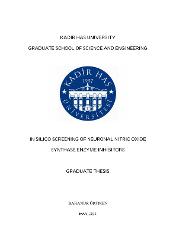| dc.contributor.advisor | Yelekçi, Kemal | en_US |
| dc.contributor.author | Örtmen, Bahanur | |
| dc.date.accessioned | 2019-07-12T08:39:40Z | en_US |
| dc.date.available | 2019-07-12T08:39:40Z | en_US |
| dc.date.issued | 2014 | en_US |
| dc.identifier.uri | https://hdl.handle.net/20.500.12469/2351 | |
| dc.description.abstract | Three closely related isoforms of nitric oxide synthases (NOS) catalyze an important secondary messenger nitric oxide (NO) synthesis through oxidation of L-arginine to L-citrulline. These three NOS isoforms takes parts in different tissues for various physiological and pathological processes. Neuronal NOS (nNOS) produce NO in central and peripheral nervous system endothelial NOS (eNOS) plays role in endothelial cells and NO in macrophage cells is produced by inducible NOS (iNOS). Excessive NO production in nervous cells following pathological conditions is observed. Dysregulation of NO therefore may force NO to act as a neurotoxin that causes several neurodegenerative diseases including Parkinson’s Alzheimer’s Huntington’s diseases. Considering all these facts developing a selective and good potential inhibitor for nNOS is a compulsory task to achieve. However among all APPE isoforms there is high active site conservation so that no drug that shows these desired properties has yet been designed and developed.in this present work virtual screening techniques were applied to design selective nNOS inhibitors. Molecular modeling studies were done using already known crystal structures of all three isoforms. First of all to find primary lead candidates several hundred compounds were screened via ZiNCv12 lead library. Then modifications were done on the selected scaffolds via de novo design method to derive our inhibitor candidates. AutoDock 4.02 docking virtual tool was employed for docking and scoring of inhibitor candidates. inhibition constants and best pose predictions of docked ligands within the active sites of three isoforms were considered for further examinations and comparison analysis. Already bound ligands in downloaded experimentally determined X-ray structures of all isoforms were re-docked to crosscheck our studies. in this thesis two lead scaffolds among all and 22 inhibitor candidates derived from these two scaffolds were selected to discuss for optimization for further development of best potential and selective inhibitor for nNOS. -- Abstract'tan. | en_US |
| dc.description.abstract | Three closely related isoforms of nitric oxide synthases (NOS) catalyze an important secondary messenger nitric oxide (NO) synthesis through oxidation of L-arginine to L-citrulline. These three NOS isoforms takes parts in different tissues for various physiological and pathological processes. Neuronal NOS (nNOS) produce NO in central and peripheral nervous system, endothelial NOS (eNOS) plays role in endothelial cells and NO in macrophage cells is produced by inducible NOS (iNOS). Excessive NO production in nervous following pathologic conditions is observed and dysregulation of NO may force NO to act as a neurotoxin that causes several neurodegenerative diseases including Parkinson's, Alzheimer's, Huntington's diseases. Considering all these facts, developing a selective and good potential inhibitor for nNOS is a compulsory task to achieve. However, among all isoforms there is high active site conservation so that no drug that shows these desired properties has yet been designed and developed. In this present work, virtual screening techniques were applied to design selective nNOS inhibitors. Molecular modeling studies were done using already known crystal structures of all three isoforms. First of all, to find primary lead candidates, several hundred compounds were screened via ZINCv12 lead library. Then, modifications were done on the selected scaffolds via de novo design method to derive our inhibitor candidates. AutoDock 4.02 docking virtual tool was employed for docking and scoring of inhibitor candidates. Inhibition constants and best pose predictions of docked ligands within the active sites of three isoforms were considered for further examinations and comparison analysis. Already bound ligands in downloaded experimentally determined X-ray structures of all isoforms were re-docked to crosscheck our studies. In this thesis two lead scaffolds among all and 22 inhibitor candidates derived from these two scaffolds were selected to discuss for optimization for further development of best potential and selective inhibitor for nNOS. | en_US |
| dc.language.iso | eng | en_US |
| dc.publisher | Kadir Has Üniversitesi | en_US |
| dc.rights | info:eu-repo/semantics/openAccess | en_US |
| dc.subject | Nitric Oxide Synthase | en_US |
| dc.subject | eNOS | en_US |
| dc.subject | iNOS | en_US |
| dc.subject | nNOS | en_US |
| dc.subject | de novo design | en_US |
| dc.subject | Docking | en_US |
| dc.subject | In silico screening | en_US |
| dc.subject | Nitrik oksit sentaz | en_US |
| dc.subject | de novo dizayn | en_US |
| dc.subject | İlaç hedeflendirmesi (docking) | en_US |
| dc.subject | in silico tarama | en_US |
| dc.title | In silico screening of neuronal nitric oxide synthase enzyme inhibitors | en_US |
| dc.type | masterThesis | en_US |
| dc.department | Enstitüler, Lisansüstü Eğitim Enstitüsü, Hesaplamalı Biyoloji ve Biyoinformatik Ana Bilim Dalı | en_US |
| dc.relation.publicationcategory | Tez | en_US |
| dc.identifier.yoktezid | 360948 | en_US |
















